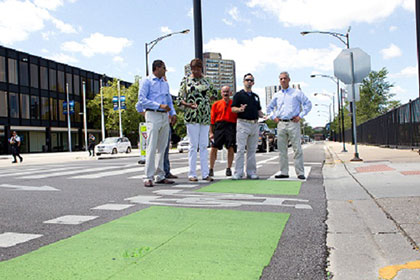Mayor Emanuel Announces City Installing 34 Miles of New Bike Lanes in 2012
Part of a Nearly 650-Mile Network of Bikeways to Be Established by 2020

Mayor Rahm Emanuel announced today that the City is building more than 30 miles of new bicycle lanes in neighborhoods across Chicago this year, part of a planned nearly 650-mile network of biking facilities to be in place by 2020 to provide a bicycle accommodation within half-mile of every Chicagoan.
“Improving our bicycling facilities is critical to creating the quality of life in Chicago that will attract businesses and families to the city,” Mayor Emanuel said. “Our plan lays the framework for Chicago to be the most bike friendly city in the United States and will create economic opportunity and jobs in our neighborhoods and throughout the city.”
Chicago’s Streets for Cycling Plan 2020, to be released later this month, sets forth a strategy to achieve Mayor Emanuel’s goal of making Chicago the best big city for bicycling in America. The Plan, developed through a community process, identifies a 645-mile bike network of on-street bikeways that will allow all Chicagoans to feel more safe and comfortable riding on city streets.
By the end of this year, the Chicago Department of Transportation (CDOT) will install 34 miles of new bike facilities, including:
- A two-way north-south protected bike route through the Loop on Dearborn Street from Polk Street to Kinzie Street. The City will also extend the Kinzie bike route east to meet up with this new route. The Dearborn bikeway will separate bicyclists from high-speed traffic and include bicycle signals to separate bicycle and motor vehicle conflicts.
- The City’s first “Neighborhood Greenway” to begin construction later this summer on Berteau Avenue, connecting the bike routes on Lincoln Avenue and Clark Street.
- The start of the Milwaukee Avenue “spoke route,” which will provide a safe and comfortable bikeway connection between the popular Kinzie and Elston protected bike lanes.
- New buffered bike lanes as part of a “road diet” on South Chicago Avenue that will increase safety for pedestrians, bicyclists and motorists. The improvement will work to reduce crashes along South Chicago Avenue, which is consistently ranked as one of the city’s highest crash corridors.
- Newly installed protected and buffered bike routes on parts of: Wabash Avenue; Halsted Street, Jackson Boulevard, 55th Street, 31st Street, Clark Street, Martin Luther King Drive and the West Side Boulevards.
The Streets for Cycling Plan 2020 identifies three kinds of bicycle routes that will form the network:
- 310 miles of Neighborhood Routes: Neighborhood Routes are quiet, mostly residential streets that connect to local destinations such as neighborhood retail, schools, parks and transit. Many of the streets identified as Neighborhood Routes are already low stress bike routes.
- 275 miles of Crosstown Bike Routes: Crosstown Bike Routes are long, continuous routes that get bicyclists across Chicago. These routes are mostly located on commercial streets and connect neighborhoods, major destinations and Neighborhood Routes. The majority of Chicago’s protected and buffered bike lanes will be located on Crosstown Bike Routes.
- 60 miles of Spoke Routes: Spoke Routes are direct routes in and out of the Loop that provide safe, continuous bikeways connecting all areas of Chicago with the downtown. The primary goal of the Spoke Routes is to increase commuting by bicycle citywide.
The Plan’s network was developed using three key principles: provide a bicycle accommodation within half-mile of every Chicagoan; provide more bikeways where more people live; and build more infrastructure where ridership is high, while establishing a strong backbone of infrastructure where ridership is currently lower.
# # #
